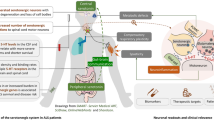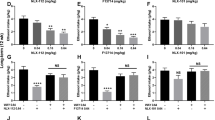Abstract
Previous studies have identified alcohol, thiamine deficiency and liver disease as contributing to the neuropathology of alcohol-related brain damage. In order to examine the effects of alcohol toxicity and thiamine deficiency on serotonergic neurons in the median raphe nucleus (MnR), alcoholic and previously published Wernicke-Korsakoff syndrome (WKS) cases without liver disease, were compared with age-matched non-alcoholic controls. While there was no difference between the estimated number of serotonergic neurons in either controls or alcoholics without WKS (means of 63,010±8,900 and 59,560±8,010 respectively), a substantial loss of serotonergic neurons was previously found in WKS cases (mean of 19,050±13,140). Further analysis revealed a significant difference in the maximum daily alcohol consumption between these groups. However, analysis of covariance showed that the number or serotonergic neurons in the MnR did not correlate with the amount of alcohol consumed. Therefore, our results suggest that cell loss in the MnR can be attributed to thiamine deficiency rather than alcoholper se.
Similar content being viewed by others
References
American Psychiatric Association. (1994).Diagnostic and Statistical Manual of Mental Disorders.Fourth Edition. American Psychiatric Association, Washington DC.
Baker, K.G., Halliday, G.M., Halasz, P. Hornung, J-P., Geffen, L.B., Cotton, R.G.H., and Törk, I. (1991a). Cytoarchitecture of serotonin-synthesizing neurons in the pontine tegmentum of the human brain.Synapse 7:301–320.
Baker, K.G., Halliday, G.M., Hornung, J-P., Geffen, L.B., Cotton, R.G.H., and Törk, I. (1991b). Distribution, morphology and number of monoamine-synthesizing and substance P-containing neurons in the human dorsal raphe nucleus.Neuroscience 42:757–775.
Baker, K.G., Halliday, G.M., and Harper, C.G. (1994). Effect of chronic alcohol consumption on the human locus coeruleus.Alcohol. Clin Exp. Res. 18:1491–1496.
Baker, K.G., Halliday, G.M., Kril, J.J., and Harper, C.G. (1996). Chronic alcoholics without Wernicke-Korsakoff syndrome or cirrhosis do not lose serotonergic neurons in the dorsal raphe nucleus.Alcohol. Clin Exp. Res. 20:61–66.
Ballenger, J.C., Goodwin, F.K., Major, L.F., and Brown, G.L. (1979). Alcohol and central serotonin metabolism in man.Arch. Gen. Psychiatry 36:224–227.
Borg, S., Kvande, H., Liljeberg, P., Mossberg, D., and Valverius, P. (1985). 5-Hydroxyindoleacetic acid in cerebrospinal fluid in alcoholic patients under different clinical conditions.Alcohol 2:415–418.
Butterworth, R.F. (1995). Pathophysiology of alcoholic brain damage: synergistic effects of ethanol, thiamine deficiency and alcoholic liver disease.Metab. Brain Dis. 10:1–8.
Coggeshall, R.A. (1992). A consideration of neural counting methods.Trends Neurosci. 15:9–13.
Cullen, K.M., and Halliday, G.M. (1995). Mechanisms of cell death in cholinergic basal forebrain neurons in chronic alcoholics.Metab. Brain Dis. 10:81–91.
Felten, D.L., and Sladek, J.R. (1982). Monoamine distribution in primate brain. V. Monoaminergic nuclei: anatomy, pathways, and local organization.Brain Res. Bull. 9:253–254.
Finlay, J.M., and Zigmond, M.J. (1995). A critical analysis of neurochemical methods for monitoring transmitter dynamics in the brain. In (F.E. Bloom, and D.J. Kupfer, eds.),Psychopharmacology: The Fourth Generation of Progress, New York, Raven Press, pp. 29–40.
George, D.T., Wozniak, K., and Linnoila, M. (1992). Basic and clinical studies on serotonin, alcohol, and alcoholism. In (C.A. Naranjo, and E.M. Sellers, eds.)Novel Pharmacological Interventions for Alcoholics. Springer-Verlag, New York. pp. 92–104.
Haan, E.A., Jennings, I.G., Cuello, A.C., Nakata, H., Chow, C.W., Kushinsky, R., et al. (1987). A monoclonal antibody recognizing all three amino acid hydroxylases allows identification of serotonergic neurons in human brain.Brain Res. 426:19–27.
Halasz, P., and Martin, P. (1985).Magellan Program for Quantitative Analysis of Histological Sections. University of New South Wales, Sydney.
Halliday, G., Ellis, J., Heard, R., Caine, D., and Harper, C. (1993). Brainstem serotonergic neurons in chronic alcoholics with and without the memory impairment of Korsakoff's psychosis.J. Neuropath. Exp. Neurol. 52:567–579.
Halliday, G., Baker, K., and Harper, C. (1995). The role of serotonin in alcohol-related brain damage.Metab. Brain Dis. 10:25–30.
Harper, C. (1979). Wernicke's encephalopathy: a more common disease than realised.J. Neurol. Neurosurg. Psychiat. 42:226–231.
Hawkins, R.A., Mans, A.M., and Biebuyck, J.F. (1987). Changes in brain metabolism in hepatic encephalopathy.Neurochem. Pathol. 6:35–66.
Hoffmann, N.G., and Ninonuevo, F.G. (1994). Concurrent validation of substance abusers self-reports against collateral information: Percentage agreement Vs. K Vs. Yule's Y.Alcohol. Clin. Exp. Res. 18:231–237.
Hornung, J-P., and Fritschy, J-M. (1988). Serotonergic system in the brainstem of the marmoset: a combined immunocytochemical and three-dimensional reconstuction study.J. Comp. Neurol. 270:471–487.
Jensen, G.B., and Pakkenberg, B. (1993). Do alcoholics drink their neurons away?Lancet 342:1201–1204.
Kril, J. (1995). The contribution of alcohol, thiamine deficiency and cirrhosis of the liver to cerebral cortical damage in alcoholics.Metab. Brain Dis. 10:9–16.
Lieber, C.S. (1994). Alcohol and the liver: 1994 Update.Gastroenterology 106:1085–1105.
Lishman, W.A., Jacobson, R.R., and Acker, C. (1987). Brain damage in alcoholism.Curr. Concepts 717(Suppl.):5–17.
Madden, J.S. (1993). The definition of alcoholism.Alcohol Alcohol. 28:617–620.
Mamounas, L.A., Mullen C.A., O'Hearn, E., and Molliver, M.E. (1991). Dual serotoninergic projections to forebrain in the rat: Morphologically distinct 5-HT axon terminals exhibit differential vulnerability to neurotoxic amphetamine derivatives.J. Comp. Neurol. 314:558–586.
Marbet, U.A., Bianchi, L., Meury, U., and Stalder, G.A. (1987). Long-term histological evaluation of the natural history and prognostic factors of alcoholic liver disease.J. Hepatology 4:364–372.
Molliver, D.E., and Molliver, M.E. (1990). Anatomic evidence for a neurotoxic effect of (±)-fenfluramine upon serotonergic projections in the rat.Brain Res. 511:165–168.
Murphy, D.L. (1990). Peripheral indices of central serotonin function in humans.Ann. N.Y. Acad. Sci. 600:282–296.
O'Hearn, E., Battaglia, G., De Souza, E.B., Kuhar, M.J., and Molliver, M.E. (1988). Methylenedioxyamphetamine (MDA) and methylenedioxymethamphetamine (MDMA) cause selective ablation of serotonergic axon terminals in forebrain: immunocytochemical evidence for neurotoxicity.J. Neurosci. 8:2788–2803.
Savolainen, V.T., Liesto, K., Männikkö, A., Penttilä, A., and Karhunen, P.J. (1993). Alcohol consumption and alcoholic liver disease: evidence of a threshold level of effects of ethanol.Alcohol. Clin. Exp. Res. 17: 1112–1117.
Symogyi, J.C., and Kopp, P.M., Filippini, L., and Monnat, A. (1980). Transketolase-TPP-effect on chronic alcoholics with various degrees of liver cirrhosis.J. Nutr. Sci. Vitaminol. 26:221–229.
Tollefson, G.D. (1989). Serotonin and alcohol: interrelationships.Psychopathology 22, Suppl. 1:37–48.
Törk, I., Halliday, G.M., and Cotton, R.G.H. (1992). Application of antiphenylalanine hydroxylase antibodies to the study of the serotonergic system in the human brain.J. Chem. Anat. 5:311–313.
Victor, M., Adams, R.D., and Collins, G.H. (1989).The Wernicke-Korsakoff Syndrome, F A Davis & Co, Philadelphia.
Victor, M. (1994). Alcoholic Dementia.Can. J. Neurol. Sci. 21:88–99.
Wilson, M.A., Ricaurte, G.A., and Molliver, M.E. (1989). Distinct morphologic classes of serotonergic axons in primates exhibit differential vulnerability to the psychotropic drug 3,4-methylenedioxymethamphetamine.Neuroscience 28:121–137.
Author information
Authors and Affiliations
Rights and permissions
About this article
Cite this article
Baker, K.G., Halliday, G.M., Kril, J.J. et al. Chronic alcoholism in the absence of Wernicke-Korsakoff syndrome and cirrhosis does not result in the loss of serotonergic neurons from the median raphe nucleus. Metab Brain Dis 11, 217–227 (1996). https://doi.org/10.1007/BF02237959
Received:
Accepted:
Issue Date:
DOI: https://doi.org/10.1007/BF02237959




